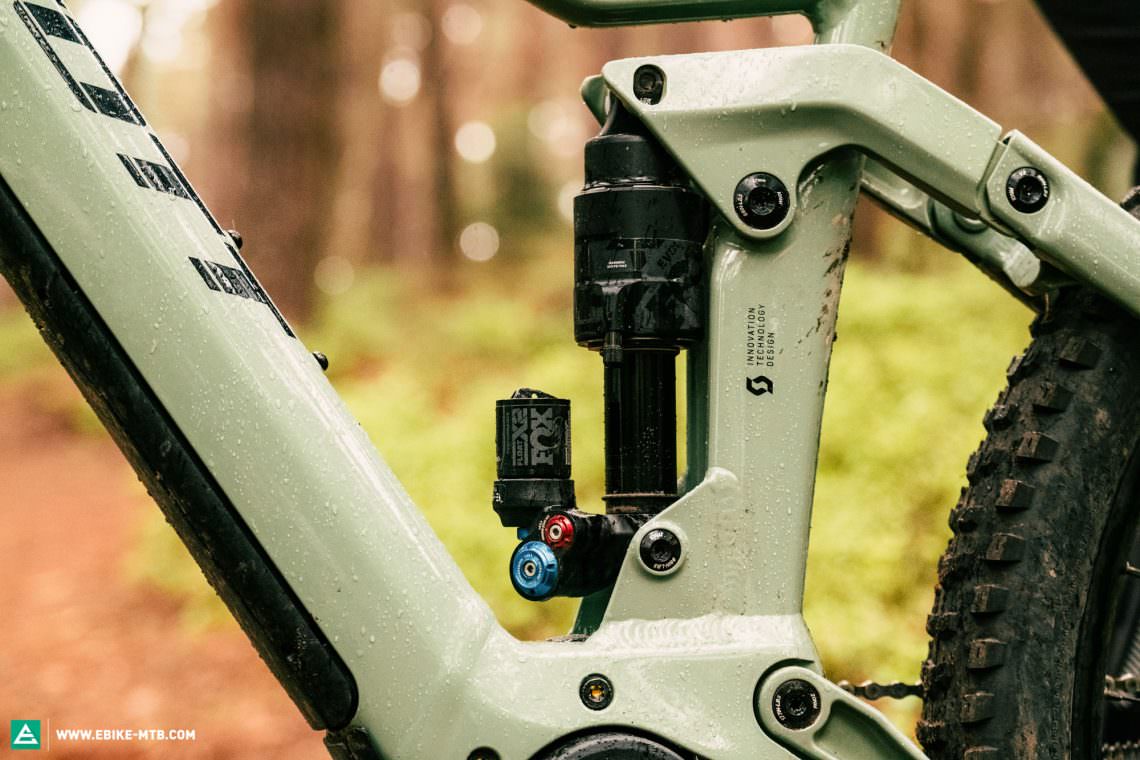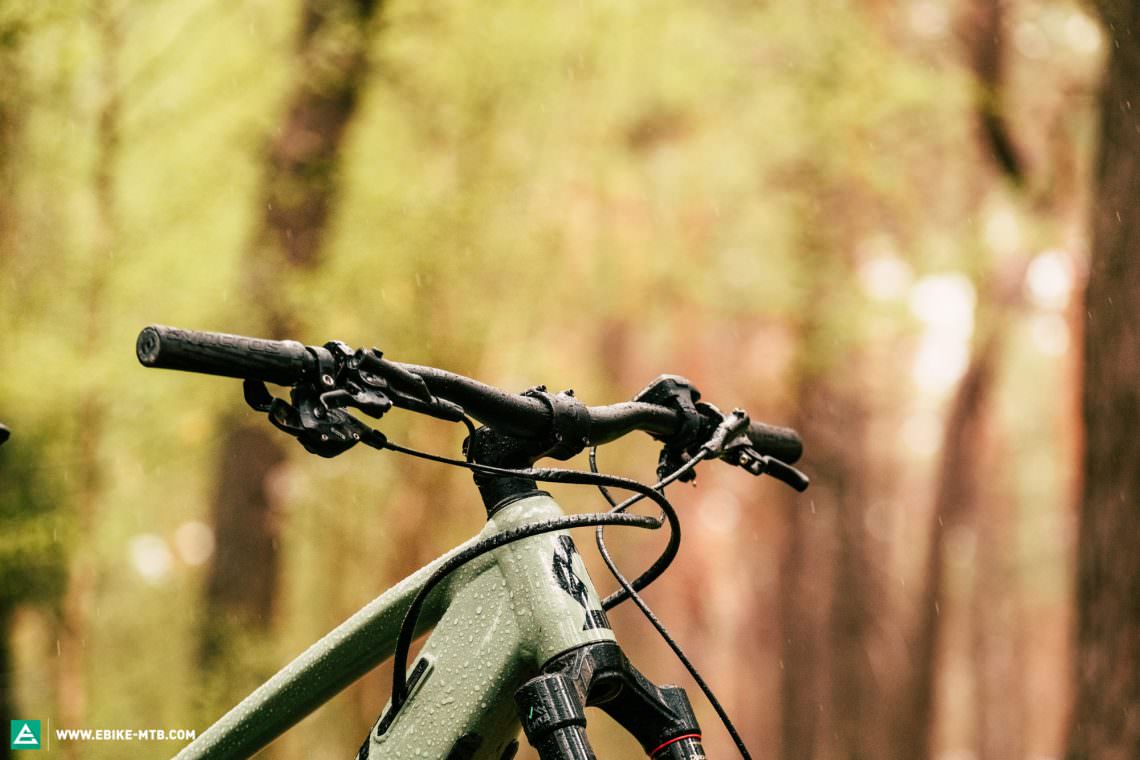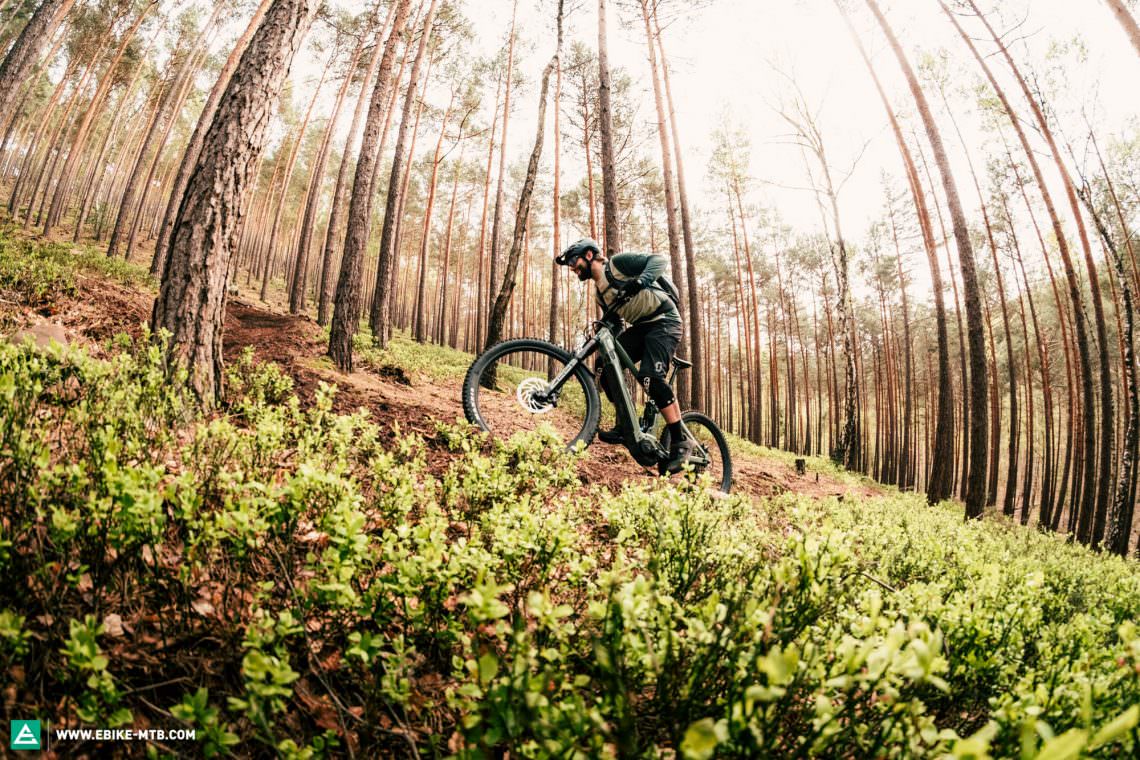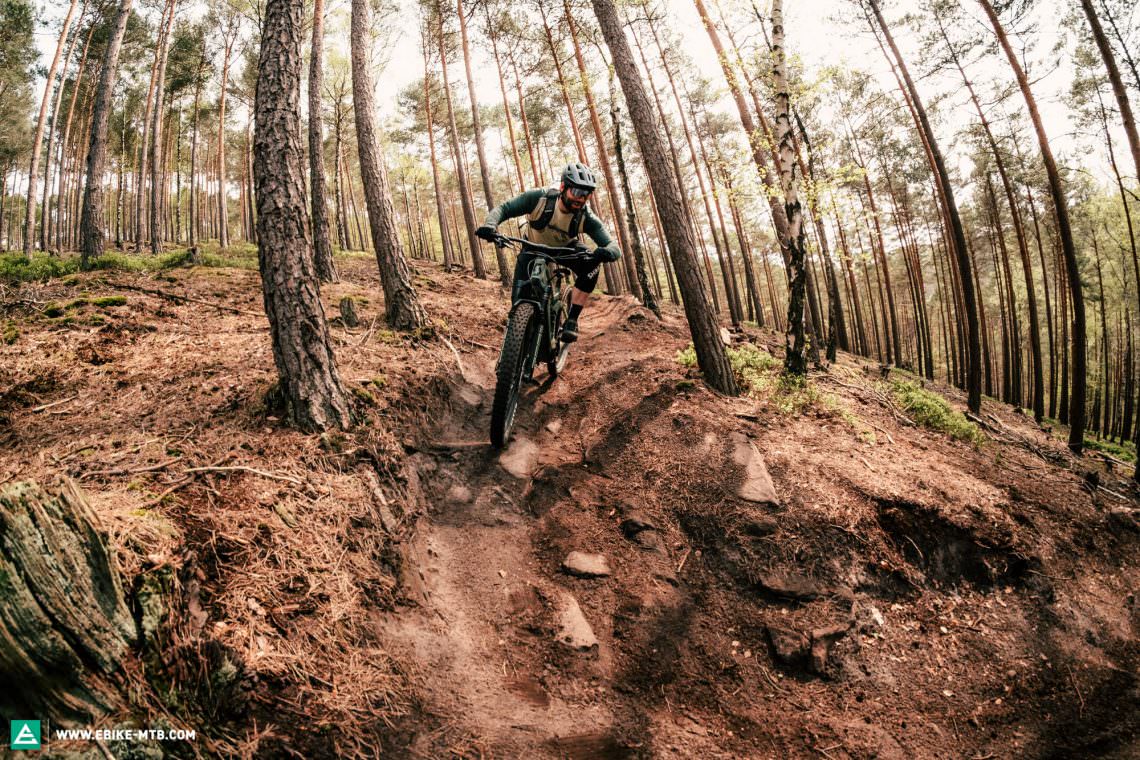The SCOTT Ransom eRIDE 910 has already secured this year’s coveted Best Buy in our mega eMTB group test of 25 of the most exciting bikes of the year. In our budget group test, the Swiss brand enters the race with the cheaper SCOTT Ransom eRIDE 920, which retails at € 5,499. But it able to assert itself as the best all-rounder?
For an overview of the test fleet head to the group test: The best eMTB of 2021 for € 5,500 – 7 budget eMTBs go head to head

24.95 kg in size L | € 5,499 | Manufacturer’s website
We’ve been waiting for this moment for a long time: the end of SCOTT’s TwinLoc system on their eMTB range has finally arrived! With its potent, downhill-oriented Ransom eRIDE, the Swiss brand ushers in a new era, finally dispensing with the fiddly lockout lever on the handlebars. As if that wasn’t enough, the new bike features a clean, updated look with a more svelte finish. The now gone TwinLoc lever avoids the usual cable clutter on the handlebars and ensures a tidy cockpit. That being said, SCOTT can’t match FOCUS’ and MERIDA’s super-clean solutions. The potent eMTB with 180 mm travel and 29″ wheels relies on a 625 Wh battery and integrates the Bosch Performance Line CX motor neatly into the frame. A rubber down tube protector guards the frame, motor and battery cover against stray rocks and forms a seamless transition to the frame. The speed sensor of the 24.95 kg eMTB (size L) is safely tucked away in the dropout – awesome! However, placing the Purion display right next to the brake lever wasn’t a great idea: this setup only allows you to adjust the position of the display to a certain extent, making it hard to reach the buttons to change the support level. On the other hand, the internal cable routing with solid cable clamps and the ribbed chainstay protector ensure a quiet ride, leaving just the distinctive clunking noise of the Bosch motor in the background. During our test, the pivot bolts came loose several times. If you don’t want to spend the day tightening up bolts, we recommend a generous helping of thread locker!



The spec of the SCOTT Ransom eRIDE 920 is its limiting factor
Like the flagship RANSOM eRIDE 910 model, the cheaper eRIDE 920 version in our test relies on a FOX X2 Performance shock, which controls 180 mm travel at the rear and contributes significantly to the suspensions’ excellent performance. However, the RockShox ZEB R fork with its Charger R damper and fixed compression setting struggles to keep up. A SRAM drivetrain with mixed SX/NX Eagle components delivers the power of the Bosch Performance CX motor to the 29” rear wheel. The wide shifter clamp interferes with the brake lever, which could cause some problems with the cockpit setup. You’ll also have to accept some compromises in terms of shifting performance, which isn’t as quick or smooth as the Shimano SLX drivetrain fitted to the other bikes in this test. In terms of both braking power and modulation, Shimano’s four-piston MT520 brakes with the budget SM-RT30 200 mm rotors are too weak for the Ransom eRIDE. Unfortunately, SCOTT’s own-brand 170 mm dropper post also left us scratching our heads. The remote is hard to reach and requires a strong thumb – dropping the saddle should be exciting, not frustrating! While both the wide 2.6 ” MAXXIS ASSEGAI tire at the front and 2.6″ DISSECTOR at the rear generate good traction, the flimsy EXO+ casing doesn’t offer adequate puncture protection, failing to do justice to the potential of the RANSOM eRIDE.
The SCOTT Ransom eRIDE 920 is held back by its spec. Unfortunately, this makes it hard to tap into the full potential of the bike.

The cheaper 920 model relies on the same FOX X2 Performance shock of the 910 flagship model. This ensures excellent traction, control and support!

The Charger R damper of the RockShox ZEB R fork offers limited adjustment options and sinks into its travel on steep descends, heavily limiting downhill performance, which is exactly what the bike was originally designed for! There’s only one thing you can do: experiment with the air pressure.

The Shimano brake lever and SRAM shifter clamps interfere, limiting the range of adjustments. This makes it hard to reach the brake lever and shifter at the same time, unless you twist your fingers.

SCOTT save money in the wrong place, combining weak Shimano MT520 brakes with cheap SM-RT30 brake rotors. Unfortunately, upgrading to sintered pads isn’t an option either because the rotors are only compatible with organic ones.
SCOTT Ransom eRIDE 920
€ 5,499
Specifications
Motor Bosch Performance Line CX 85 Nm
Battery Bosch PowerTube 625 Wh
Display Bosch Purion
Fork RockShox ZEB R 180 mm
Rear Shock FOX X2 Performance 180 mm
Seatpost Syncros Duncan 125–170 mm
Brakes Shimano MT520/501 200/200 mm
Drivetrain SRAM SX/NX-Eagle 1x12
Stem Syncros XM1.5 60 mm
Handlebar Syncros Hixon 2.0 Rise 800 mm
Wheelset Formula CL/Syncros MD30 29"
Tires MAXXIS ASSEGAI/DISSECTOR EXO+ 2.6"
Technical Data
Size S M L XL
Weight 24.95 kg
Perm. total weight 128 kg
Max. payload (rider/equipment) 103 kg
Trailer approval yes
Kickstand mount yes

The MAXXIS DISSECTOR tire with its thin EXO+ casing doesn’t offer adequate puncture protection for aggressive trail riding. If you want to tap into the full potential of the bike, you should run the more robust DoubleDown casing, at least at the rear.

A chunky rubber pad protects the frame, motor and battery from stray rocks and rowdy park park sessions.

The spoke magnet for the Bosch motor is safely tucked away in the Shimano rotor.

Um am Cockpit Ordnung zu schaffen, verlässt sich SCOTT auf Spiralschläuche. Mit den eleganten Lösungen, die FOCUS oder MERIDA fürs Kabelmanagement anbieten, kann das SCOTT nicht mithalten.
SCOTT Ransom eRIDE 920 – Touring capabilities and geometry
At 465 mm, the chainstays are relatively long, having a significant influence on the handling of the SCOTT. The 470 mm reach in size L, combined with the high 649 mm front and 170 mm Syncros Duncan dropper post, ensure good freedom of movement in all directions. The steep seat tube angle generates an upright and central pedalling position, which is very comfortable uphill but puts a lot of weight on the saddle on level terrain.
| Size | S | M | L | XL |
|---|---|---|---|---|
| Seat tube | 420 mm | 440 mm | 470 mm | 500 mm |
| Top tube | 568 mm | 569,5 mm | 595,5 mm | 597,0 mm |
| Head tube | 120 mm | 120 mm | 125 mm | 125 mm |
| Head angle | 64.0° | 64.0° | 64.0° | 64.0° |
| Seat angle | 76.5° | 76.3° | 76.1° | 75.9° |
| Chainstays | 465 mm | 465 mm | 465 mm | 465 mm |
| BB Drop | 22 mm | 22 mm | 22 mm | 22 mm |
| Wheelbase | 1,230 mm | 1,255 mm | 1,288 mm | 1,318 mm |
| Reach | 415 mm | 440 mm | 470 mm | 500 mm |
| Stack | 644,4 mm | 644,4 mm | 649 mm | 649 mm |

Jersey SCOTT Defined Dri | Shorts SCOTT Trail Vertic | Shoes Crankbrothers Mallet E BOA
Socks SCOTT Performance No Shortcuts Crew | Gloves SCOTT Enduro LF
Building on the success of its bigger brother? The SCOTT Ransom eRIDE 920 on test
Against all expectations, the SCOTT is in its element on the climbs, single-handedly shattering all preconceptions about long travel bikes. The steep seat tube angle positions the rider centrally on the bike, even on steep climbs. This position, together with the long chainstays and the efficient kinematics which keep the suspension high in its travel, glues the front wheel to the trail, allowing the Ransom to wind its way uphill while negotiating corners playfully and with plenty of flow. The sensitive suspension transfers the power of the motor to the trail efficiently and takes the edge off steep, technical trail sections on loose terrain, despite the low-profile tread of the DISSECTOR rear tire. If you’re looking for a bike that encourages you to take on new technical challenges, the SCOTT might be what you’re looking for. Here only the Propain Ekano is a smidge better. On the other hand, if you want to pull manuals out of berms and switchbacks, you be better served taking a closer look at the MERIDA eONE-SIXTY.

Mit dem Ransom eRIDE 920 gelingen Schlüsselstellen im Uphill super. Im Downhill kann es daran leider nicht an die klasse Uphill-Performance anknüpfen.


Tuning tips: tires with more robust casing (e.g. MAXXIS DoubleDown) | thread lock all suspension pivot bolts
Downhill, the riding position is nicely central and integrates the rider between the big wheels. In combination with the high front, this conveys huge amounts of confidence on steep terrain. The front wheel sticks to the ground even in open corners and on loose terrain, making the Ransom eRIDE easy to control at slow to medium speeds. Rolling over medium-sized obstacles is child’s play! On very steep terrain, the fork offers too little support and sinks into its travel, pulling your weight over the handlebars. Given the limited adjustment options of the fork, you’ll have to experiment with different air pressures in order to find the optimal balance between responsiveness and support. In reality, the SCOTT loves to get rowdy downhill and to go fast. However, the spec stops it from doing so: the brakes aren’t powerful enough and the tire casings are too flimsy for high-speed laps. On top of that, the suspension ends up feeling unbalanced, with the RockShox ZEB R struggling to keep up with the rear suspension in terms of support, control and precision. As a result, the SCOTT falls behind some of its competitors, exactly where it should perform best – downhill. If you’re looking for a bike for technical singletracks and fast-paced trail sessions, you should take a closer look at the Propain Ekano or MERIDA eONE-SIXTY. Alternatively, you could just dig a bit deeper and go for the Ransom eRIDE 910 flagship model, which retails for € 6,999.

Riding Characteristics
7Agility
- sluggish
- playful
Stability
- nervous
- stable
Handling
- demanding
- balanced
Riding fun
- boring
- lively
Motor feeling
- digital
- natural
Motor power
- weak
- strong
Value for money
- poor
- top
Conclusion
The SCOTT Ransom eRIDE 920 was originally designed for rowdy trail sessions, technical terrain and fast bike park tracks, yet that’s exactly where its spec spoils the party, heavily limiting its trail performance. The affordable Ransom eRIDE 920 is only an option for beginners or for advanced riders who are looking for huge reserves, good climbing qualities and intuitive handling but don’t care too much about pushing their limits downhill.
Tops
- rear suspension performance
- climbing qualities
- intuitive handling
Flops
- cockpit ergonomics
- pivot bolts come loose
- tires, fork and brakes limit the potential of the bike

You can find out more about at scott-sports.com
The test field
For an overview of the test fleet head to the group test: The best eMTB of 2021 for € 5,500 – 7 budget eMTBs go head to head
All bikes in test: Canyon Spectral:ON CF 7 (Click for review) | FOCUS JAM² 6.9 NINE (Click for review) | Haibike AllMtn 4 (Click for review) | INFRONT IF-2.1 Fully (Click for review) | MERIDA eONE-SIXTY 700 (Click for review) | Propain Ekano AL 29 (Click for review) | SCOTT Ransom eRIDE 920

Relaxed and comfortable riding on surfaced roads, both uphill and downhill.↩
Easy climbs up trails with few obstacles, wide turns and a moderate incline.↩
Active and playful descents on easy trails with few obstacles, wide turns and a moderate slope.↩
Single-track climbs on challenging terrain. Loose ground, steps, roots, tight corners and occasionally extreme inclines.↩
Singletrack descents on challenging terrain. Loose ground, steps, roots, tight corners and small jumps as well as some very steep descents.↩
High speed descents on sometimes very rough trails with large jumps and obstacles that you can’t roll over.↩
The rating used for riding characteristics refers to the bikes in the group test and the current state of development of eMTBs. The best bikes managed to blend supposedly opposite riding characteristics, feeling both lively and stable at the same time. The handling describes the balance of the bike on downhill sections. The information regarding motor-power refers to the ride-feeling in the overall context of the bike and not exclusively to the motor – that’s why the same motor can present different values.↩
Did you enjoy this article? If so, we would be stoked if you decide to support us with a monthly contribution. By becoming a supporter of E-MOUNTAINBIKE, you will help secure a sustainable future for high-quality cycling journalism. Click here to learn more.
Words: Photos: Felix Stix & Peter Walker









